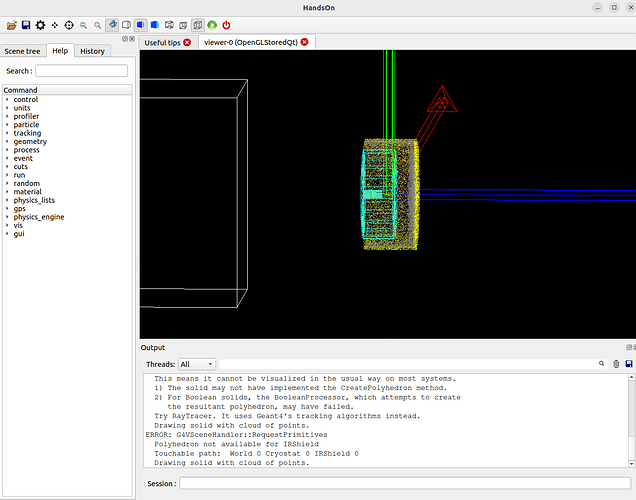_Geant4 Version: geant4-11-02-patch-02 [MT] (21-June-2024)
_Operating System: Ubuntu 64bit
_Compiler/Version:_g++ (Ubuntu 11.4.0-1ubuntu1~22.04) 11.4.0
_CMake Version: 3.22.1
// ------------------------- NIST 재료 정의 -------------------------
G4Material* matGe = nist->FindOrBuildMaterial(“G4_Ge”);
G4Material* matAl = nist->FindOrBuildMaterial(“G4_Al”);
G4Material* matAir = nist->FindOrBuildMaterial(“G4_AIR”);
// ------------------------- Crystal -------------------------
G4double crystal_radius = 42.5mm;
G4double crystal_height = 30.0mm;
G4Tubs* solidCrystal = new G4Tubs(“Crystal”, 0, crystal_radius, crystal_height/2, 0., 360.*deg);
G4Tubs* solidCore = new G4Tubs(“Core”, 0, 3.5mm, 9.0mm, 0., 360.deg);
G4SubtractionSolid solidCrystalFinal = new G4SubtractionSolid(“CrystalWithCore”, solidCrystal, solidCore, 0, G4ThreeVector(0,0,-6.0mm));
G4LogicalVolume logicCrystal = new G4LogicalVolume(solidCrystalFinal, matGe, “Crystal”);
G4VisAttributes* visCrystal = new G4VisAttributes(G4Colour(0.0, 1.0, 1.0, 1.0)); // 불투명 Cyan
visCrystal->SetForceSolid(true);
logicCrystal->SetVisAttributes(visCrystal);
// ------------------------- IR Shield -------------------------
G4double ir_outer_radius = 50.9mm;
G4double ir_thickness = 1.5mm;
G4double ir_body_height = 45.9mm;
G4double ir_cap_thickness = 1.5mm;
G4Tubs* irBody = new G4Tubs(“IRBody”, ir_outer_radius - ir_thickness, ir_outer_radius, ir_body_height/2, 0., 360.deg);
G4Box irCut = new G4Box(“IRCut”, ir_outer_radius+1mm, ir_outer_radius+1mm, ir_cap_thickness/2);
G4SubtractionSolid* irOpen = new G4SubtractionSolid(“IROpen”, irBody, irCut, 0, G4ThreeVector(0, 0, -ir_body_height/2 + ir_cap_thickness/2));
G4Tubs* irCap = new G4Tubs(“IRCap”, 0, ir_outer_radius, ir_cap_thickness/2, 0., 360.deg);
G4UnionSolid irWhole = new G4UnionSolid(“IRShield”, irOpen, irCap, 0, G4ThreeVector(0,0,ir_body_height/2));
G4LogicalVolume* logicIR = new G4LogicalVolume(irWhole, matAl, “IRShield”);
G4VisAttributes* visIR = new G4VisAttributes(G4Colour(0.5, 0.5, 0.5, 1.0)); // 불투명 Grey
visIR->SetForceSolid(true);
logicIR->SetVisAttributes(visIR);
// ------------------------- Cryostat -------------------------
G4double cryo_outer_radius = 52.5mm;
G4double cryo_thickness = 1.6mm;
G4double cryo_body_height = 50.0mm;
G4double cryo_cap_thickness = 1.6mm;
G4Tubs* cryoBody = new G4Tubs(“CryoBody”, cryo_outer_radius - cryo_thickness, cryo_outer_radius, cryo_body_height/2, 0., 360.deg);
G4Box cryoCut = new G4Box(“CryoCut”, cryo_outer_radius+1mm, cryo_outer_radius+1mm, cryo_cap_thickness/2);
G4SubtractionSolid* cryoOpen = new G4SubtractionSolid(“CryoOpen”, cryoBody, cryoCut, 0, G4ThreeVector(0, 0, -cryo_body_height/2 + cryo_cap_thickness/2));
G4Tubs* cryoCap = new G4Tubs(“CryoCap”, 0, cryo_outer_radius, cryo_cap_thickness/2, 0., 360.deg);
G4UnionSolid cryoWhole = new G4UnionSolid(“Cryostat”, cryoOpen, cryoCap, 0, G4ThreeVector(0,0,cryo_body_height/2));
G4LogicalVolume* logicCryostat = new G4LogicalVolume(cryoWhole, matAl, “Cryostat”);
G4VisAttributes* visCryo = new G4VisAttributes(G4Colour(1.0, 1.0, 0.0, 1.0)); // 불투명 Yellow
visCryo->SetForceSolid(true);
logicCryostat->SetVisAttributes(visCryo);
// ------------------------- Hierarchical Placement (with margin) -------------------------
G4double margin = 0.1 * mm;
G4double z_crystal_in_ir = -(ir_body_height - crystal_height)/2.0 + margin;
G4double z_ir_in_cryo = -(cryo_body_height - ir_body_height)/2.0 + margin;
new G4PVPlacement(0, G4ThreeVector(0, 0, z_crystal_in_ir), logicCrystal, “Crystal”, logicIR, false, 0, true);
new G4PVPlacement(0, G4ThreeVector(0, 0, z_ir_in_cryo), logicIR, “IRShield”, logicCryostat, false, 0, true);
new G4PVPlacement(0, {}, logicCryostat, “Cryostat”, lv_World, false, 0, true);
When I write the code as shown below, the Cryostat and IR Shield appear hazy in the Qt viewer; I’m wondering how I can make them fully opaque. Also, is it safe to run the simulation in this state?
